Gliderunning: Part 3: How to choose running shoes
Welcome to the third blog post in our series on running. My name is Michelle Ball, and I am a Gokhale Method® teacher in Tasmania. I am a lifelong runner and am passionate about sharing my experience with beginners as well as seasoned runners and everyone in between. Even if you don’t run, but do wear shoes, this blog post is for you!
Active feet come first
When it comes to advice about running, our feet often get sidelined by the subject of shoes. If you missed Part 2, which is about how to build healthy, active feet, we recommend you catch up here.
The job of a good running shoe—performance and protection
At the level of elite sport, running shoes are designed with increasingly sophisticated technologies to enhance performance. Time will tell what long-term effect these may have on athletes. From the Gokhale Method® point of view the primary purpose of all shoes is to protect our feet and our weight-bearing joints while still allowing us to move as Nature intended.
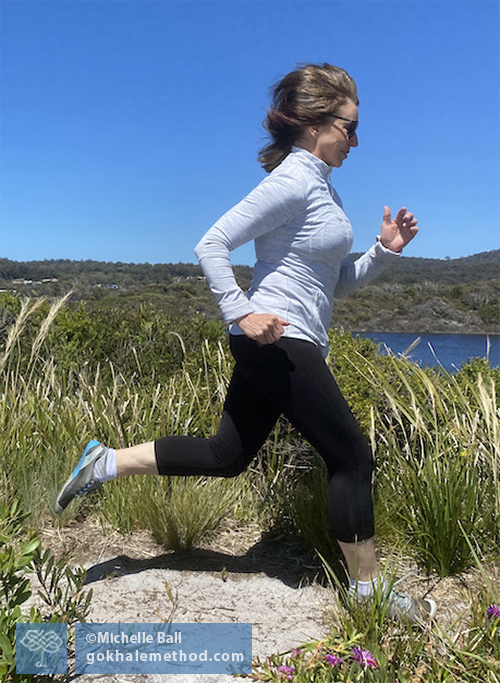
A lightweight, barefoot-style shoe gives my feet sufficient protection and lets them be active on a soft, forgiving surface like this sandy coastal trail.
Cushioning the joints
Over the last 50 years, the increase in urban running on hard surfaces, combined with a reduction in healthy posture and biomechanics, has made for a perfect storm of running injuries. These include runner’s knee (patellofemoral syndrome), Achilles tendonitis, shin splints (stress involving microfractures of the tibia), and plantar fasciitis (inflammation of the bottom of the foot). The design of modern running shoes has seen many innovations, twists, and turns, but one clear trend has been to increase the amount of protective padding in the form of thicker, spongier soles, air bladders, and gel at chambers. Whilst some degree of cushioning for the joints is desirable when running on unnaturally hard surfaces, it is now thought that overly thick soles reduce proprioceptive sensitivity and actually encourage runners to hit the ground harder.
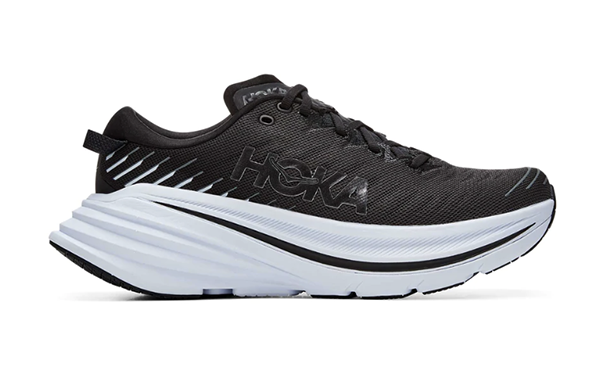
This contemporary road running shoe is heavily padded. From the Gokhale Method perspective, such bulk interferes with our ability to feel the ground and make softer landings and can encourage ankle turnover. Run4it
Strong, responsive feet combined with the natural gait pattern that arises from healthy posture can enable you to land more softly and avoid injury. Building in extreme cushioning cannot compensate for excessive heel strike and its damaging impact on poorly aligned joints.
Healthy alignment of the ankle
The first time I experienced a running injury was in my twenties. I had bought a new pair of shoes. The salesman measured me and recommended shoes that were designed to prevent overpronation (inward turn) of the foot. They felt good in the store, but after rolling my ankles more than once, I realized the shoes recommended were predisposing me to injury. I found out later that I tended to supinate my feet very slightly and not pronate them. Having shoes that were heavily padded on the inside edge to keep my foot from rolling in, increased the chance of my foot rolling out. The result for me was torn lateral ligaments and crutches on several occasions for six weeks at a time. Once I even had a hairline fracture on the ankle coming down off a boulder. I learned the hard way how important it is to have your ankles well aligned. After buying shoes for normal ankle alignment, I didn’t roll my ankles anymore.

Your weight should align centrally and distribute evenly (left). In overpronation (center) weight bears down more on the inner foot and the ankle veers inward, and in supination (right) weight is carried on the outer foot as the ankle veers outward.
You can do a simple check on your ankle alignment using a mirror or have someone take a photograph. You want to be able to see your heel and ankle from behind.
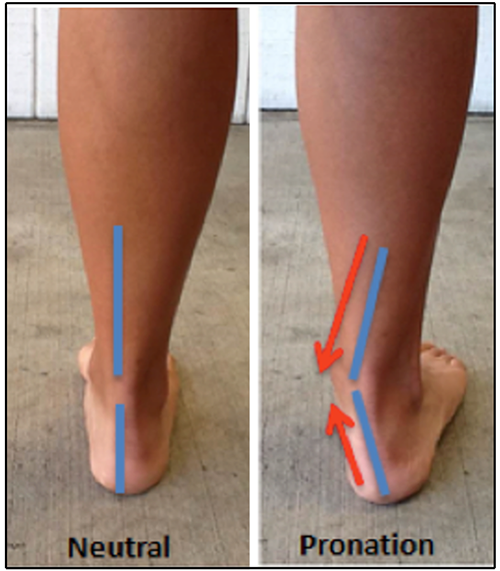
An overpronated foot may show distortion of the Achilles tendon (right). Wikimedia
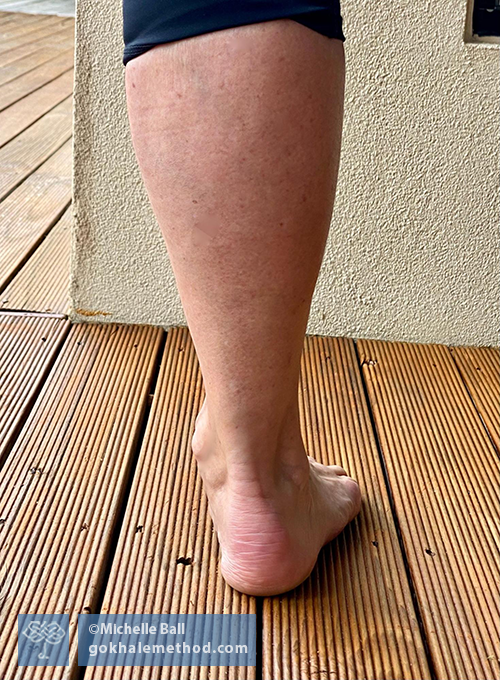
Poor ankle alignment may also show up as an ankle bone protruding markedly over the edge of the heel. Here my inner ankle bone shows I am overpronating my foot.
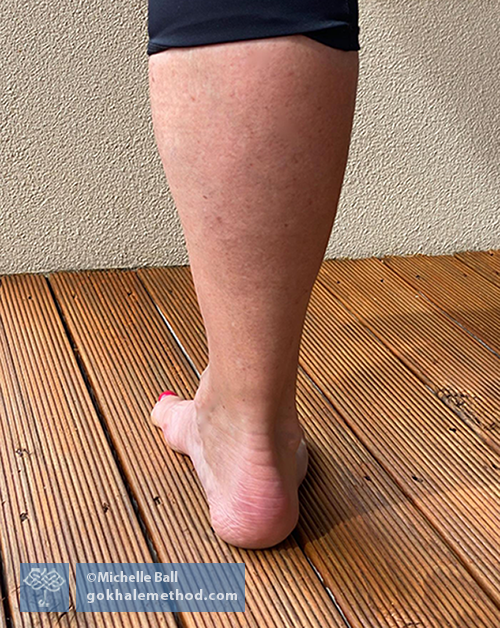
Kidney-bean shaping my foot has now aligned my ankle well. The Achilles tendon is straight, and each ankle bone is better aligned on either side of the heel.
You can also get useful information by examining the soles of your shoes, which may show more wear and tear along the inner (overpronation) or outer (supination) edge. Check several pairs to ensure that what you see is not peculiar to just one pair of shoes. Compare the left and right shoe.
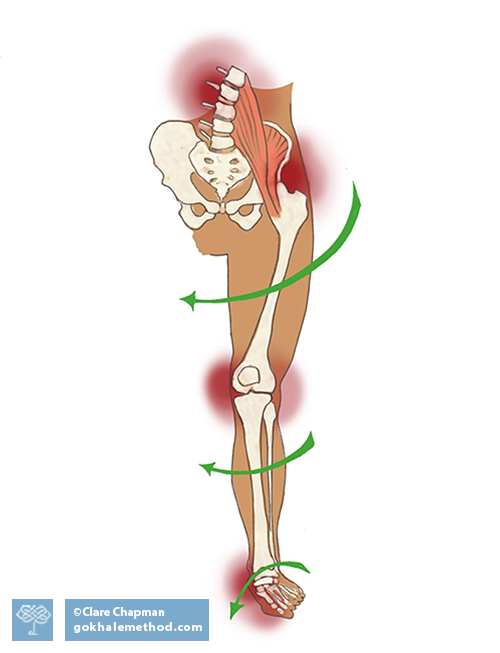
This diagram shows how overpronation of the foot can misalign the ankle, knee, hip and spinal joints further up the chain.
Healthy shoes need to be foot-shaped!
One of the most common faults with modern shoes—including running shoes—is the shape of the toe area, or toe box. The toe box of most shoes is tapered to some degree, which distorts the natural kidney-bean foot shape that the encourages. We are all familiar with the pointed toe in many women’s fashion shoes, men’s winklepickers, and even cowboy boots—yet it surprises me how this tapering persists in sports and activity footwear. Even some shoes marketed as “barefoot” or “natural” reflect the conventional wisdom of a straight foot, rather than a healthy bean-shaped one.
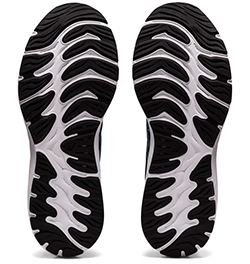
Most running shoes assume the feet to be straight and tapered at the toes (left). Nature’s blueprint for our feet maintains the external rotation and kidney-bean shape that we all have as infants (right). This is preserved throughout adulthood in traditional societies and explained in Esther Gokhale’s book, 8 Steps to a Pain-Free Back.
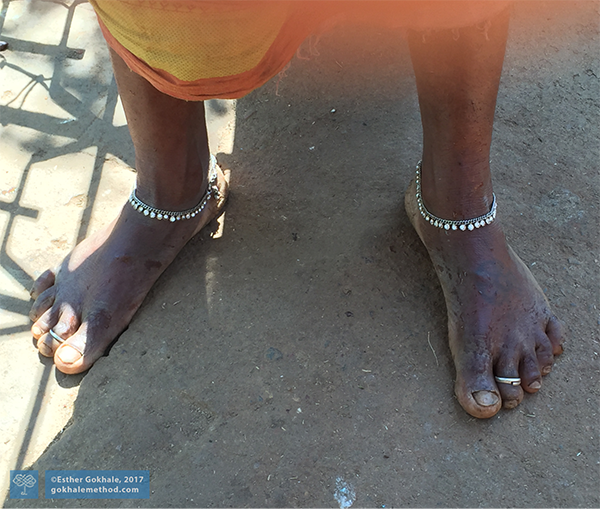
Note the bean-shaped contours and wide toes of this Indian woman’s feet. (Odisha, India, 2017)
This strong, active foot would be constrained and deformed by a tapered running shoe.
Tipping forward/curve in modern shoes
Shoes with an upward toe curve have become increasingly popular. People like the feeling of forward momentum that they give, and they can encourage the glutes to work. Better to learn to use your glutes anyway, then this feature isn’t necessary, and you avoid the downside—the upward toe curve encourages your foot to peel off the ground passively, rather than grab and propel you forward.

An upward toe curve depresses the transverse arch at the base of the toes. This concavity directs excessive weight through the ball of the foot and contributes to weaker plantar muscles and push-off. Run4it
I hope this blog post has helped you with your choice of running shoes. If you are in the market for a new pair, enjoy shopping with new confidence and purpose.

I simply love this series and
I simply love this series and am eager to apply what I learn to start running. Can you please tell us what shoes you use for running and your other recommendations? It will narrow down choices immensely. It's a shoe jungle out there!
I am running in Merrel Goves.
I am running in Merrel Goves. I also like Vivobarefoot
Thank you for this. I am
Thank you for this. I am about to start running as part of my exercise so this is perfect timing.
There are even some podiatrists/surgeons that believe the upward toe curve is creating plantar fasciosis because the toe being held up tightens the abductor hallucis which might restrict blood flow to the plantar fascia resulting in tissue death. I switched to a barefoot shoe with a nice wide toe box this year and it has made a difference already, avoiding that hard heel strike and naturally slipping into the glide walking while also strengthening my arches.
This article was so helpful
This article was so helpful since I often feel off balance in some of my shoes. I was able to find my Xero shoes checked off all the good things to look for in a shoe.
Interesting article. I
Interesting article. I always thought the more padding, the better. So many athletic shoes are made with memory foam now too. Since I am in need of a new pair of athletic shoes - for walking specifically - I wonder if you can give any recommendations? Thank you.